
Original Link: https://www.anandtech.com/show/2510
AMD's Phenom X3 8000 Series: Fighting Two Cores with Three?
by Anand Lal Shimpi on April 23, 2008 9:00 AM EST- Posted in
- CPUs
AMD has been pretty active on the CPU front lately, last month we saw the Phenom re-launch with the B3-stepping 50-series quad-core processors and today AMD is unveiling its 50-series triple-core parts.
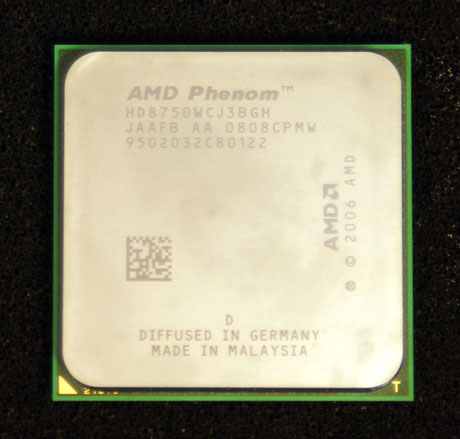
We've got the lineup below:
| Cores | Stepping | Clock Speed | TDP | L2 Cache | L3 Cache | 1 Ku Price | |
| AMD Phenom X4 9850 | 4 | B3 | 2.5GHz | 125W | 2MB | 2MB | $235 |
| AMD Phenom X4 9750 | 4 | B3 | 2.4GHz | 125W | 2MB | 2MB | $215 |
| AMD Phenom X4 9550 | 4 | B3 | 2.2GHz | 95W | 2MB | 2MB | $209 |
| AMD Phenom X3 8750 | 3 | B3 | 2.4GHz | 95W | 1.5MB | 2MB | $195 |
| AMD Phenom X3 8650 | 3 | B3 | 2.3GHz | 95W | 1.5MB | 2MB | $165 |
| AMD Phenom X3 8450 | 3 | B3 | 2.1GHz | 95W | 1.5MB | 2MB | $145 |
Note that all three of the triple-core parts are 50-series CPUs, meaning they are based on the B3 stepping and do not suffer from the TLB erratum that plagued the early Phenom processors. AMD continues to ship B2 stepping CPUs, but most of them are to OEMs that aren't as concerned with the performance hit associated with the software TLB fix.
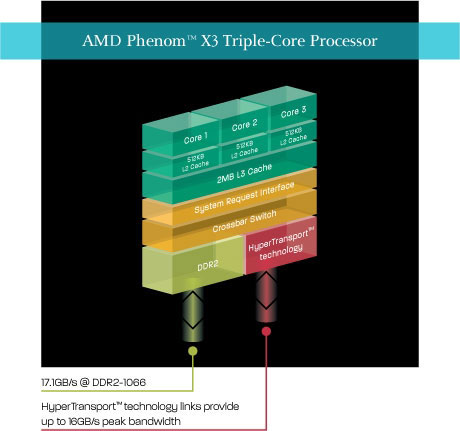
Pricing is also pretty interesting, as the top end Phenom X3 8750 is only $20 cheaper than the quad-core Phenom X4 9750 despite running at the same clock speed. The X3 8650 and 8450 are far more interesting as both of them are priced closer to $150.
There's now some overlap between AMD's triple-core Phenom and dual-core Athlon X2 offerings in terms of price, have a look:
| Cores | Clock Speed | TDP | L2 Cache | L3 Cache | 1 Ku Price | |
| AMD Phenom X3 8750 | 3 | 2.4GHz | 95W | 1.5MB | 2MB | $195 |
| AMD Phenom X3 8650 | 3 | 2.3GHz | 95W | 1.5MB | 2MB | $165 |
| AMD Phenom X3 8450 | 3 | 2.1GHz | 95W | 1.5MB | 2MB | $145 |
| AMD Athlon X2 6400+ | 2 | 3.2GHz | 125W | 2MB | 0MB | $178 |
| AMD Athlon X2 6000+ | 2 | 3.0GHz | 125W | 2MB | 0MB | $167 |
| AMD Athlon X2 5600+ | 2 | 2.8GHz | 89W | 2MB | 0MB | $146 |
The Athlon X2s still hold a tremendous clock speed advantage, but Phenom can do more work per clock. It will be interesting to see if three Phenom cores at 2.1GHz are a better buy than two Athlon X2 cores at 2.8GHz.
Why Bother with Three Cores?
The table below shows the problem with four cores:
| SYSMark 2007 Overall | E-Learning | Video Creation | Productivity | 3D | |
| Intel Celeron 420 (1 core, 512KB, 1.6GHz) | 55 | 52 | 55 | 54 | 58 |
| Intel Celeron E1200 (2 cores, 512KB, 1.6GHz) | 76 | 68 | 91 | 70 | 78 |
| % Increase from 1 to 2 cores | 38% | 31% | 65% | 30% | 34% |
| Intel Core 2 Duo E6750 (2 cores, 4MB, 2.66GHz) | 138 | 147 | 141 | 120 | 145 |
| Intel Core 2 Quad Q6700 (4 cores, 8MB, 2.66GHz) | 150 | 145 | 177 | 121 | 163 |
| % Increase from 2 to 4 cores | 8.7% | 0% | 26% | 1% | 12% |
When going from one to two cores, overall system performance increases a decent amount. SYSMark encapsulates a wide variety of applications and usage models and overall performance increases by close to 40%. Obviously areas like video encoding (represented in the Video Creation tests) see the biggest gain, but all aspects of performance increase tremendously. Making the argument for two cores these days isn't a difficult one, most desktop applications can at least take some advantage of two cores.
Looking at the move from two to four cores however reveals much worse scaling. In our 1-to-2 core comparison cache size didn't increase, so the theoretical scaling could actually be even higher but in the 2-to-4 core comparison the total L2 doubles since Intel's quad-core processors are simply two dual-core die on a single package. Despite the increase in cache size however, scaling is quite poor. Overall performance goes up 8.7% percent and the E-Learning/Productivity tests see no gains at all. Once again the biggest gains come from the Video Creation tests, followed by the 3D suite.
For the vast majority of systems, four cores just aren't necessary. There are some applications that do scale very well between 2 and 4 cores, but the overall landscape is much like what we saw with dual-core CPUs circa 2005, the time for quad just isn't now. Intel's CPU shipments also reflect that both the need and demand for quad-core CPUs just isn't very high:

Currently, less than 10% of Intel's consumer desktop CPU shipments are quad-core and that number won't grow much beyond 10% by the end of 2008. But just like the early days of dual-core, we'll see a steady ramp up continuing in the years ahead.
The point here isn't that quad-core processors aren't necessary, rather they aren't quite in their prime as far as demand goes. With such a small portion of the market purchasing quad-core CPUs, the ISVs aren't exactly jumping at the opportunity to make sure all applications scale well from 2-to-4 cores. Some inherently won't scale while others may with additional effort, which requires a large install base and once more we find ourselves in the midst of an overused analogy involving chickens and eggs.
For Intel, a slow adoption of quad-core CPUs isn't much of a problem. It's just as easy to make a Core 2 Quad as it is to make a Core 2 Duo, the former simply has two dual-core die on the package instead of one. For AMD however, things are a lot more complicated.
One often cited reason for Phenom's late arrival was its "native" quad-core design. Due to its on-die memory controller/north bridge, AMD could not simply take two Athlon X2 die and individually place them on the same package; all four cores would have to be behind the memory interface, meaning that all four cores would have to be on the same die.
| Number of Cores | Manufacturing Process | Transistor Count | Die Size | |
| AMD Phenom X4 | 4 | 65nm | 450M | 285 mm^2 |
| AMD Phenom X3 | 3 | 65nm | 450M | 285 mm^2 |
| AMD Athlon X2 | 2 | 90nm | 243M | 219 mm^2 |
| AMD Athlon X2 | 2 | 65nm | 221M | 118 mm^2 |
| Intel Core 2 Quad | 4 | 65nm | 582M | 286 mm^2 |
| Intel Core 2 Duo | 2 | 65nm | 291M | 143 mm^2 |
| Intel Core 2 Quad | 4 | 45nm | 820M | 214 mm^2 |
| Intel Core 2 Duo | 2 | 45nm | 410M | 107 mm^2 |
Looking at the die size column you can see an issue with AMD's current processor lineup. AMD likes building the 65nm Athlon X2s, they are nice and small at 118 mm^2 per die and it can make a lot of them on a single 65nm wafer. The Athlon X2 6400+ is still built on a 90nm process and its die, by comparison, is huge; AMD doesn't like making these chips very much (update: AMD has actually ceased production of 90nm X2s altogether).
Then we have Phenom. At 285 mm^2, Phenom is huge and AMD can't make that many per wafer, plus with such a large die the yield is lower than on a smaller chip. The triple-core Phenom X3 gives AMD something to do with those quad-core die that have a single defective core, rather than throwing the entire chip away it can now be repackaged and sold as a triple-core processors.
The other problem here is that there is no dual-core Phenom, so AMD must battle Intel's 45nm dual-core processors with its very old 65nm Athlon X2s. The Phenom X3 is designed to help alleviate the burden of those poor K8s by competing with Intel's dual-core in the sub-$200 space. It's a great marketing story too: you can get three cores from AMD for the price of two from Intel.
It's more likely than not that AMD's yields aren't bad enough to have too many quad-core Phenom processors with two defective cores, which is probably why we don't see a 285 mm^2 Phenom X2.
AMD has no plans to make a separate triple-core die, simply because it would require quite a bit of engineering resources and the need for triple-core CPUs diminishes over time as quad-core adoption increases. Right now AMD is focused on bringing its 45nm Phenom processors to market and those are occupying all of AMD's availability engineering resources. Should triple-core prove to be a worthwhile addition to the lineup, AMD could always work on designing a tri-core die but for now it will fulfill its role as a stopgap solution.
A Newcomer from Intel: The Core 2 Duo E7200
A couple of weeks before the Phenom X3 launch Intel sent this little gem:

That's the Core 2 Duo E7200, it's due out sometime this quarter and it's supposed to sell for $133. The 45nm dual-core E7200 runs at 2.53GHz, with a 1066MHz FSB and has a 3MB L2 cache. Given what we reported in our last CPU story, we don't expect to see Intel hit the $133 mark with this chip until 45nm dual core shipments ramp up in late Q2/early Q3. A quick search online reveals the E7200 selling for around $160 today.
Intel also trimmed the pricing on some of its CPUs, the Core 2 Quad Q6600 now sells for $224 and the Core 2 Duo E6850 is now priced at $183.
Mainstream Platforms: Intel has an Issue
In the sub-$200 CPU space, most of these chips will be paired up with a motherboard that supports integrated graphics. For AMD that means the new 780G chipset and for Intel that means G35. Now from a general performance standpoint, these two chipsets perform very much like their more expensive, enthusiast-class siblings (790FX and P35/X48). You may give up 2 - 3% in the way of performance but motherboards are much cheaper and you get the benefit of integrated graphics, which is more than sufficient if your usage doesn't including heavy 3D gaming.
Unfortunately, Intel is in a not-so-great position right now when it comes to its platforms. It can't turn to ATI anymore for integrated graphics solutions, and with a full out war on NVIDIA brewing, it's left alone to provide chipsets for its processors as NVIDIA's latest IGP solutions are not yet available for Intel CPUs.
While G45 will hopefully bring full H.264/VC1/MPEG-2 decode acceleration to Intel's integrated graphics, it's just not ready yet. And while ATI/NVIDIA have historically held the integrated graphics performance advantage, now it's arguably even bigger. Without full HD-decode support on its chipsets, it's not just gamers that Intel is alienating, the platforms are preventing further adoption of Blu-ray on the PC.
So what are the options for OEMs? Either go with an AMD platform, or stick an AMD or NVIDIA graphics card in their Blu-ray enabled Intel machines. Neither option is something that Intel should be happy with right now. Intel's forthcoming G45 chipset does, at least in theory, solve this problem - however it's at least a couple of months away from being released.
As far as mainstream platforms go, AMD is definitely the winner here. The CPU performance leaves much to be desired, but for once (for once), we actually have a tangible platform advantage on the desktop. Now if you pirate your HD movies then none of this matters, as GPU accelerated H.264 decode doesn't work on much pirated content.
The Test
| CPU: |
AMD Phenom X4 9750 (2.4GHz) |
| Motherboard: | Gigabyte GA-MA78GM-S2H (AMD 780G) Intel DG35EC (Intel G35) |
| Chipset: | AMD 780G Intel G35 |
| Chipset Drivers: |
AMD Catalyst 8.4 |
| Hard Disk: | Western Digital Raptor 150GB |
| Memory: | Corsair XMS2 DDR2-800 4-4-4-12 (1GB x 2) |
| Video Card: | eVGA GeForce 8800 GT SSC (only for Gaming Tests, IGP for the rest) |
| Video Drivers: | AMD Catalyst 8.4 Intel NVIDIA ForceWare 169.25 |
| Desktop Resolution: | 1920 x 1200 (Vista Basic Theme) |
| OS: | Windows Vista Ultimate 32-bit SP1 |
Overall System Performance - SYSMark 2007
SYSMark 2007 is an application benchmark suite that plays back real world usage scenarios in four categories (E-Learning, Video Creation, Productivity and 3D), using the following applications:
Adobe After Effects 7
Adobe Illustrator CS2
Adobe Photoshop CS2
AutoDesk 3ds Max 8
Macromedia Flash 8
Microsoft Excel 2003
Microsoft Outlook 2003
Microsoft PowerPoint 2003
Microsoft Word 2003
Microsoft Project 2003
Microsoft Windows Media Encoder 9 series
Sony Vegas 7
SketchUp 5
WinZip 10.0
Performance is measured in each individual category and then an overall score is reported.
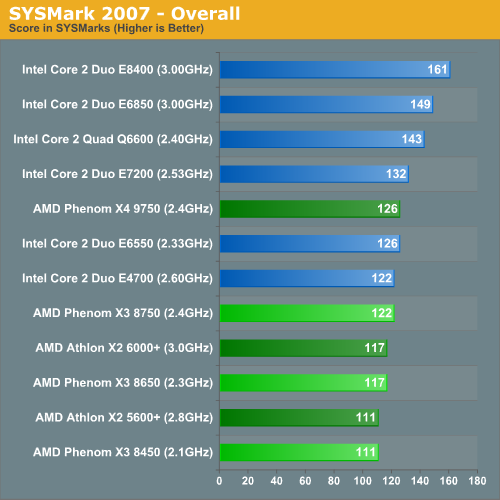
AMD's Phenom continues to suffer under SYSMark, looking at overall system performance - Intel's Core 2 lineup is just stronger. The fastest triple-core CPU is on par with Intel's $133 dual-core E4700. It's also worth mentioning that the triple-core Phenom CPUs are barely any faster than the higher clocked, dual-core Athlon X2s.
Also pay close attention to the Core 2 Duo E7200, this little beauty manages to offer better performance than the E6550 despite having a slightly smaller L2 cache and slower FSB (3MB vs. 4MB and 1066MHz vs. 1333MHz).
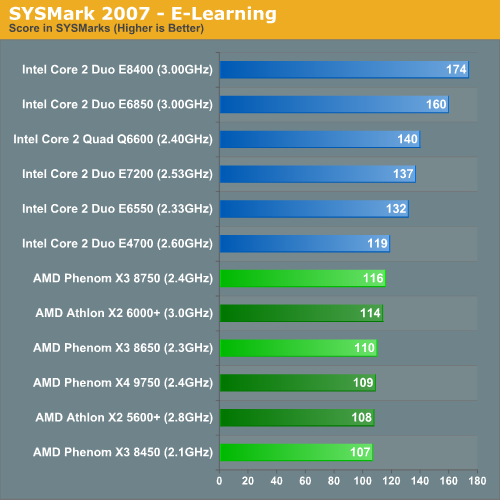
The E-Learning suite mostly echoes what we saw in the overall SYSMark results.
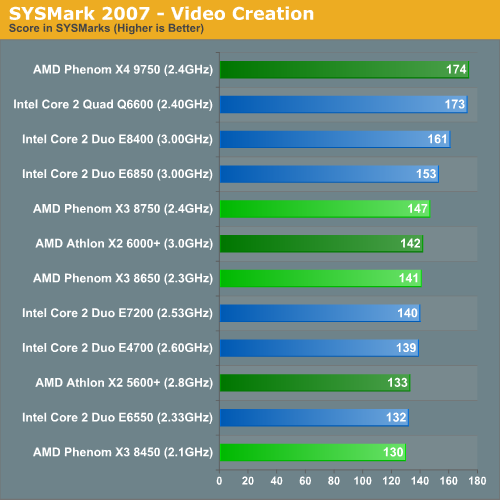
The Video Creation tests have the triple-core Phenom X3 far more competitive, the fastest entry in the chart is actually the Phenom X4 9750.

The last two test suites show results in-line with what we've already seen under SYSMark: AMD's Phenom wasnt particularly speedy with four cores, and disabling one of them doesn't help any.
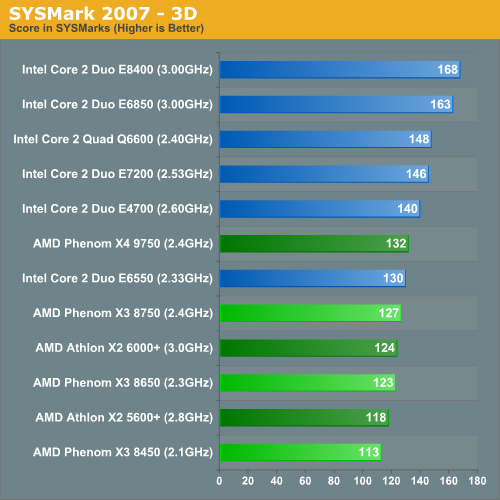
3D Rendering Performance
3dsmax r9
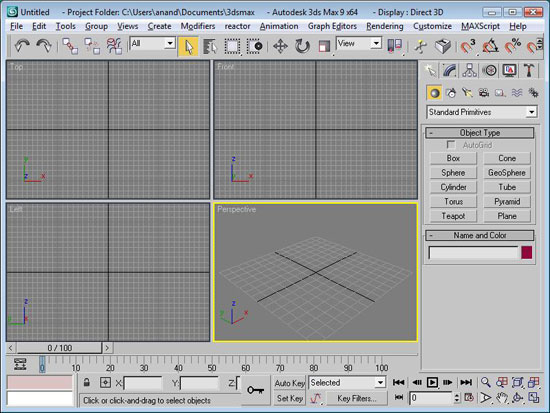
Our benchmark, as always, is the SPECapc 3dsmax 8 test but for the purpose of this article we only run the CPU rendering tests and not the GPU tests.
The results are reported as render times in seconds and the final CPU composite score is a weighted geometric mean of all of the test scores.

We've started testing with Windows Vista Service Pack 1, which for some reason really penalizes Intel in our 3dsmax benchmark. The CBALLS2 benchmark (a part of the SPECapc test) runs significantly slower on Intel platforms than it used to, resulting in a far more competitive landscape under 3dsmax.
Thanks to its on-die memory controller, the Phenom X3 is able to remain competitive at lower clock speeds than Intel but the problem is that it's not quite competitive enough. The Core 2 Duo E8400 and Phenom X3 8750 are similarly priced and perform virtually identically here, but the E8400 only has two cores vs. three in the Phenom thanks to a significant clock frequency disparity (3.0GHz vs. 2.4GHz).
Cinebench R10

A benchmarking favorite, Cinebench R10 is designed to give us an indication of performance in the Cinema 4D rendering application.
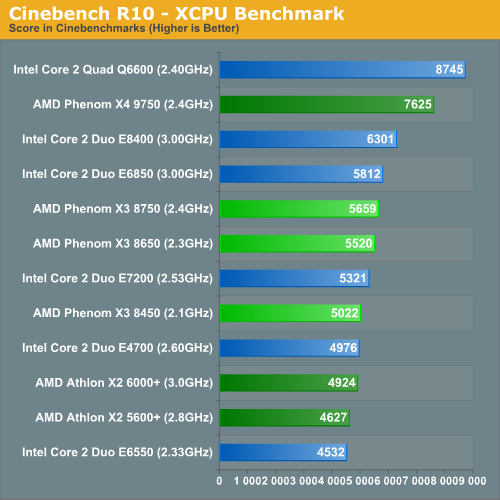
Competing within AMD, the Phenom X3 8650 is around 12% faster than the Athlon X2 6000+, and the 8450 almost 9% faster than the equivalently priced Athlon X2 5600+. The problem is that both chips are about the speed of Intel's Core 2 Duo E7200 and not even the fastest X3 8750 can outperform the Core 2 Duo E6850.
AMD continues to offer a reasonable upgrade to Socket-AM2 motherboard owners who are lucky enough to be on AMD's compatibility list, but falls short of being anything but an mild alternative to Intel at this point.
POV-Ray 3.7 Beta 24

POV-Ray is a popular raytracer, also available with a built in benchmark. We used the 3.7 beta which has SMP support and ran the built in multithreaded benchmark.
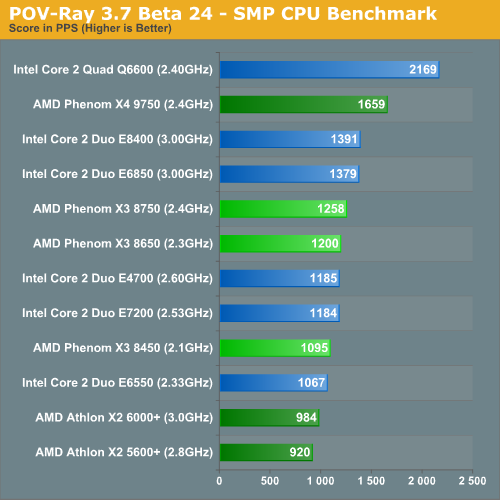
High Definition Media Encoding
DivX 6.8 with Xmpeg

Our DivX test is the same one we've run in our regular CPU reviews, we're simply encoding a 1080p MPEG-2 file in DivX. We are using an unconstrained profile and enhanced multithreading is enabled.
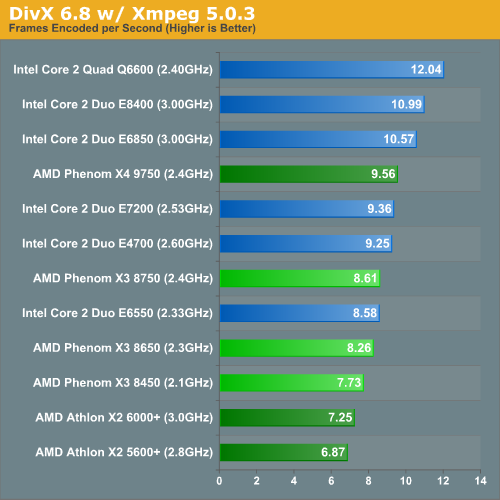
DivX encoding performance hasn't really been a strongpoint of Phenom and what's even more disappointing here is that despite having an additional core and higher IPC, the Phenom X3's clocks are so low that the older Athlon X2s are able to come within striking distance. Only the 8650 and 8750 are clocked high enough to actually separate themselves from the faster Athlon X2s.
That being said, the Core 2 Duo E4700 manages to outperform all of the X3 lineup at a price lower than all.
Windows Media Encoder 9
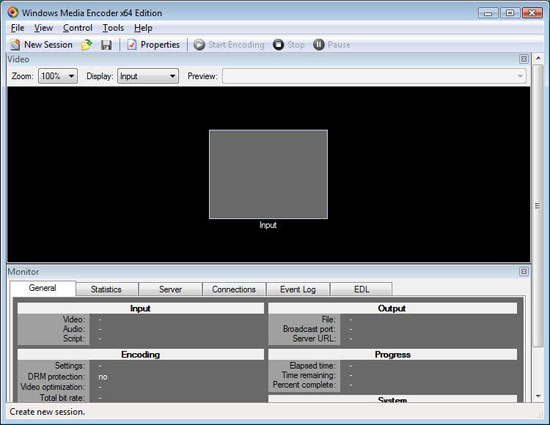
Using Windows Media Encoder's advanced video profile we encode a 500MB AVI file, this is the same test we've run in other CPU reviews.

Windows Media Encoder is actually hardcoded to only support powers of two number of cores and thus we see no benefit to the third core in this test. There are a few applications where triple-core will run into this sort of an issue and there's simply no workaround until the ISV, in this case Microsoft, updates the application itself.
Based on how competitive the Phenom X4 9750 is here, we'd expect a fairly good showing from the Phenom X3 if all three cores were operational but since they aren't the performance is around the level of a Core 2 Duo E4700.
x264 Encoding with AutoMKV
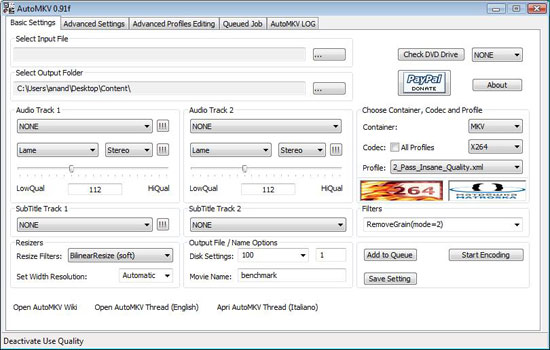
Using AutoMKV we compress the same source file we used in our WME test down to 100MB, but with the x264 codec. We used the 2-pass Balanced encoding profile.
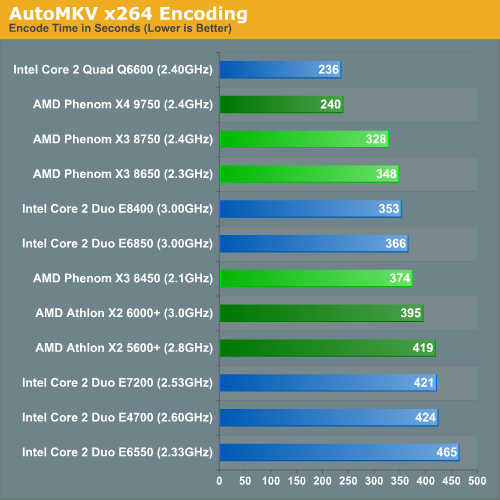
Our x264 encoding test shows the Phenom X3 actually slightly outperforming Intel's similarly priced dual-core offerings, the race is very close here.
Gaming Performance
Supreme Commander

Supreme Commander is a popular RTS (Real Time Strategy) title that can be very CPU dependent. Our benchmark involves playing back, as fast as possible, a 4-person match and recording the simulation time for the replay in seconds.
We ran Supreme Commander at 1920 x 1200 with High fidelity presets, v-sync was disabled.
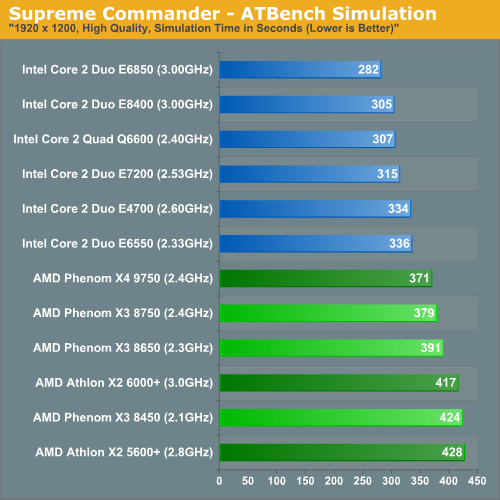
None of the AMD CPUs manage to do well here at all and despite Supreme Commander's ability to utilize more than two cores, the added benefit is small enough that triple-core doesn't really do much at all. Here we have another example of the Phenom X3 8450 performing on-par with the similarly priced Athlon X2s.
Crysis

The most demanding FPS on the market right now is Crysis, and we couldn't resist using it as a benchmark. We ran at 1024 x 768 with Medium Quality defaults and used the game's built in CPU benchmark.

Clock speed is king under Crysis and thus the fastest AMD processor is the old 90nm Athlon X2 6000+ running at 3.0GHz, unfortunately not even it is really fast enough to be competitive here. Armed with low clock speeds, Phenom need not apply.
Half Life 2 Episode Two

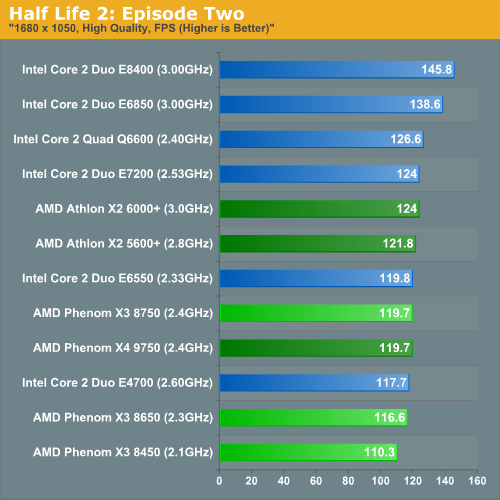
Half Life 2 continues the trend: the architectural enhancements of Phenom aren't enough to overcome its horrendously low clock speeds, the fastest AMD chip here is the aging Athlon X2.
Unreal Tournament 3
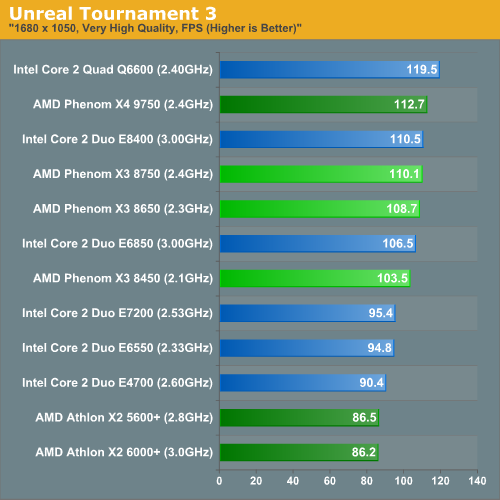
We finally see some balance in Unreal Tournament 3 thanks to some clever multi-threaded development. Here we see that modern code can run faster on Phenom than the Athlon X2, despite being at a significant clock speed disadvantage. Even compared to Intel, AMD manages to remain reasonably competitive but never quite superior.
Valve Map Compilation
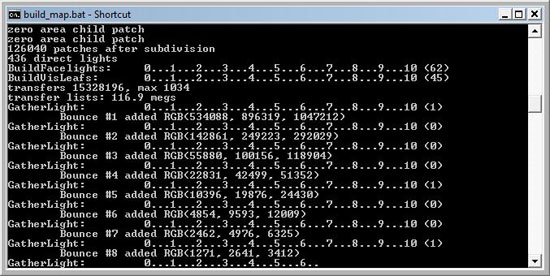
Valve supplied us with their VRAD map compilation tool to measure the performance of compiling Source engine maps.
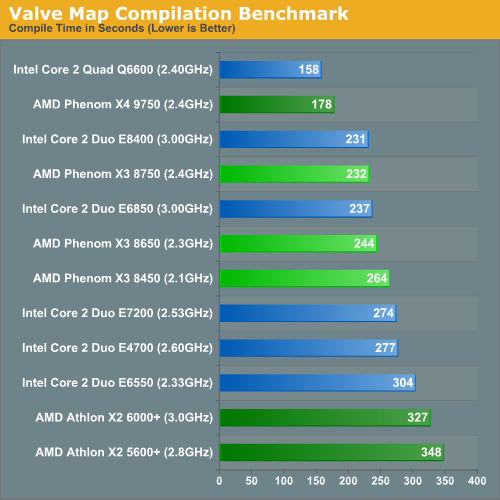
Valve's VRAD map compilation test scales very well with multiple cores and thus the Phenom X3 is pretty competitive here. AMD doesn't have the clock speed to compete against Intel's 3.0GHz E8400, so it must compete with more cores and it's exactly what we see here. The X3 8750 only runs at 2.4GHz but manages to perform on par with the 3.0GHz Core 2 Duo E8400 thanks to having that third core, which in this case is well utilized.
Unfortunately the map compilation test highlights a major issue with the triple-core strategy. Just as AMD is banking on not many applications needing quad-core, most applications don't need tri-core either and if you're running an application that doesn't benefit from three cores then the Phenom X3 behaves like a dual-core chip with a low clock speed. It's only in these well-threaded applications that triple-core can really shine, and they unfortunately aren't always the most common.
Power Consumption
For our power consumption numbers we only used CPUs that we actually had (rather than underclocking CPUs to simulate others).
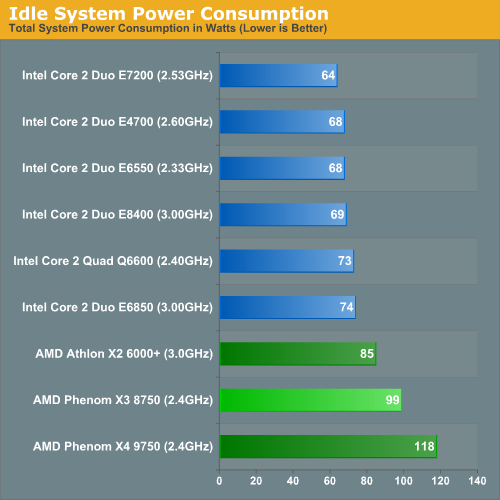
Cool 'n' Quiet brings the Athlon X2's clock speed down low enough where, despite being made on a 90nm process, it actually draws less power than the 65nm triple and quad-core Phenom chips. The problem is that even the 6000+ doesn't run as cool as the rest of the Intel lineup here.
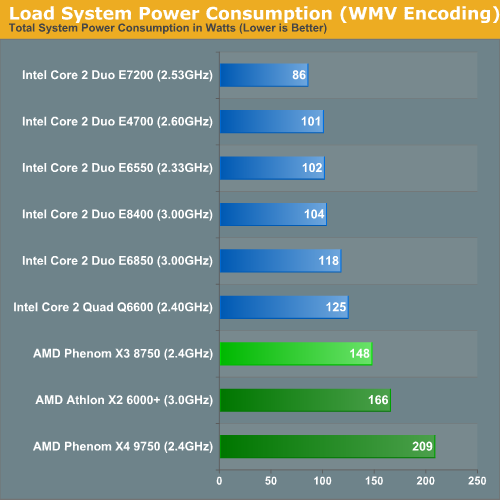
At the same clock speed, the power savings of a triple-core Phenom X3 vs. a quad-core X4 are tremendous. Unfortunately, despite much lower power consumption the X3 8750 still consumes more power than a much faster quad-core Core 2 Q6600. To make matters worse, the comparison will quickly shift to the Q9300 as availability increases and we already know how much better Intel's 45nm process is when it comes to power consumption.
Final Words
If you step back and look at it, the triple-core Phenom story isn't unexpected at all. In applications where quad-core benefits, triple-core does too and in those applications where it doesn't, we don't see much from the new Phenom X3. In video encoding and 3D rendering tasks we see triple-core do quite well, but quad-core does even better. Take this train of thought one step further and you come to a very interesting conclusion: AMD's triple-core Phenom is a quick and dirty way of using Phenom to compete in the dual-core space.
AMD doesn't have the resources to spin a dual-core Phenom die, so what better way of repurposing the quad-core die (especially if one core is defective) than to make a Phenom chip with less than four cores. Sure it's not the most efficient way to manufacture, but AMD doesn't have the luxury of producing a number of different Phenom die at this point. The triple-core Phenom strategy makes perfect sense if you're AMD, the question is: does it make sense if you're an end user?
Let's start at the Phenom X3 8750; it's priced too closely to the X4 9750 to make sense, if you need more than two cores spend the extra $20 and get a quad-core (or give up 200MHz and get a quad-core X4 9550 at the same price) and if you don't need more than two cores then you're looking at the wrong CPU to begin with.
The Phenom X3 8650 manages to perform at about the level of a 2.00GHz - 2.66GHz Core 2 Duo processor in many applications, the problem is that it needs to compete with a 3.00GHz Core 2 Duo to make economic sense. In many cases, the 8650 is competitive but with higher power consumption it's hard to call it a winner here.
The Phenom X3 8450 on the other hand is a little too slow for most applications, it's often times no faster than the Athlon X2 5600+ despite a higher IPC and having a third core. AMD needs frequency; the X3s should start at 2.4GHz and then we might be having a very different discussion, but right now the best AMD can muster is to only hold on while competing with Intel.
For any sort of 3D rendering (or other application that scales well with four cores), AMD's triple-core CPUs can offer mostly competitive performance with Intel's equivalently priced dual-core CPUs. However, as we showed early on in this article, many applications don't scale well beyond two cores and thus in the rest of our tests AMD is competitive but can't clearly be recommended.
Now if we look at the platform, AMD does actually have an advantage. The AMD 780G's integrated graphics is a far better solution for the casual gamer than what Intel offers with its G35 but on top of that, 780G offers full H.264/VC-1/MPEG-2 decode acceleration making it a far better platform for watching Blu-ray movies. With the format war over and Blu-ray drives unbelievably affordable right now, this is a serious issue for Intel.
If you're building something with integrated graphics for use as a casual gaming box or HTPC, then your best bet is AMD despite the slower CPU. Intel's G45 chipset should resolve the HD movie playback issue by also accelerating H.264/VC-1/MPEG-2 and alleviate some of the integrated graphics gaming issues with a faster 3D core, but the platform isn't due out until later in Q2 so until then there's very little choice.
The balance here is very interesting: Intel has CPU superiority with platform deficiency, and AMD has platform superiority with a serious CPU deficiency. The problem is that, in theory, G45 will fix a major issue with Intel's platforms but what will AMD do for its CPUs?







